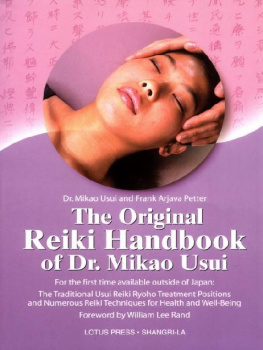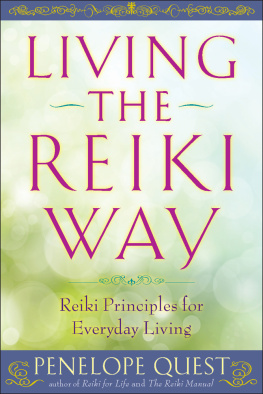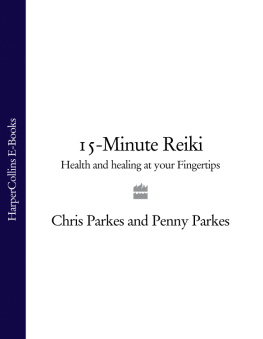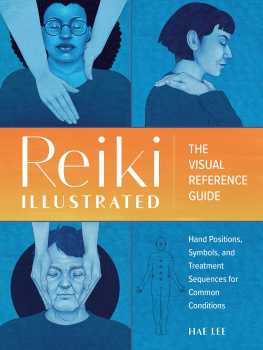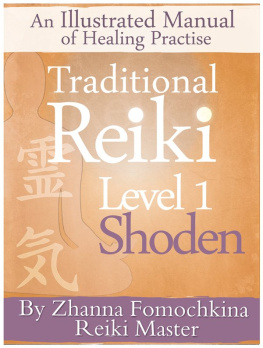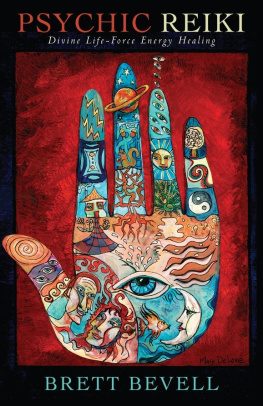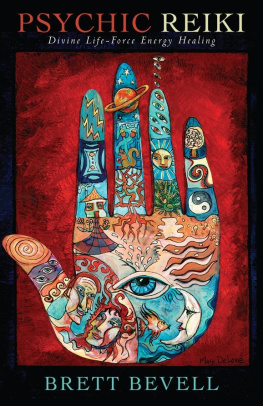Table of Contents
Important Note:
The information presented in this book has been carefully researched and passed on according to our best knowledge and conscience. However, the author and publisher assume no liability whatsoever for damages of any kind that occur directly from the application or use of the statements in this book. This information is meant as further education for interested parties. The methods of healing and exercises listed in this book are no substitute for consulting a physician or naturopath. They are meant to support the healing process as an additional treatment. The laws of the USA permit the practice of medicine only by registered physicians and healing practitioners who have been trained in accordance with the law.
Frank Arjava Petter
In 1993 he brought Reiki back to the land of its origin and was the first Westener to teach the Reiki Master/Teacher Degree in Japan. Together with his Japanese wife Chetna, he traced back the various Reiki streams to their roots, the original system of Dr. Mikao Usui and discovered along with exciting historical facts, new and fascinating healing techniques from the origins of this fantastic system.
Frank Arjava Petter currently teaches together with his wife Chetna original Reki techniques in seminars and lectures. His books Reiki Fire and Reiki-The Legacy of Dr. Usui have already become international bestsellers.
Second English Edition 2000 by Lotus Press
Box 325, Twin Lakes, WI 53181, USA
The Shangri-La Series is published in cooperation with Schneelwe Verlagsberatung, Federal Republic of Germany 1998 by Windpferd Verlagsgesellschaft mbH, Aitrang, Germany
All rights reserved
Translated by Christine M. Grimm
Cover design by Kuhn Graphik, Digitales Design, Zurich, by using a picture of P.T Grigg Interior illustrations: Shouya P.T. Grigg,
Picture of Dr. Usui on page 6: by T. Oishi
Drawings by: Peter Ehrhardt
Calligraphies: Shunyu Chikai (on page 9), Japanese typography: by Chetna Kobayashi
ISBN 0-914955-57-8
Printed in Germany
Expression of Thanks
During the past few years, a feeling of gratitude has grown in my heart, a deep thankfulness toward every moment of my life. A thankfulness toward all the people and the situations that I have encountered on my path. A thankfulness without a goal and without a source.
Yet, I would like to express my heartfelt thanks to a few friends, without whose assistance this work would have not been completed: first, my wife Chetna for her love and inexhaustible energy that she shares with me every day of our lives; and T. Oishi and Shizuko Akimoto for their boundless trust. The Windpferd team for its competent and loving support on the professional, as well as the personal, level. Walter Lbeck, who encourages me time and again to keep on researching ; Christine M. Grimm for her lovely translation from German to English; Shunyu Chikai for the radiant calligraphy on the next page; Shouya P.T. Grigg for the wonderful photos that depict the spirit of Reiki so well. My loving thanks also to our supermodel Kumiko Kondo and to Masano Kobayashi, my mother-in-law, for the transcription of the Usui Memorial.
This book is also dedicated to the very special memory of Fumio Ogawa, who died in the summer of 1998: In the name of the worldwide Reiki community, I thank him posthumously for all the information that he so open-heartedly shared with us.
And naturally a sincere thank-you to all of you, my dear readers, for the thousands of letters, love, and suggestions with which you have showered me.
Foreword
A powerful process is taking place on the planet that is destined to bring about the peace we so desperately need. The end of the cold war, the improvement in global communications and the developing understanding that all the people of the world can and must work together if the planet is to survive is acting to transform our most basic concepts. A greater feeling of security along with the acceptance that the world has a viable future is encouraging people to create positive changes that support a peaceful planet.
Part of this process involves dispelling old restrictive beliefs and replacing them with the truth. As this happens people are gaining freedom and are in a better position to create a more desirable world.
We see this process taking place in the world of Reiki. The original western version of Reiki has been questioned and people are discovering more accurate information about its history and practice from which all can benefit. Over the past several years Arjava Petter and his Japanese wife Chetna Kobayashi have been uncovering important information concerning the origin and practice of Reiki in Japan. In spite of opposition from those in the west who would benefit by maintaining the status quo, they have proceeded with their research and with the publication of this book, are sharing their most important discoveries. The fact that Usui sensei had a training manual he gave to all his Reiki students is of paramount importance. It demonstrates that Reiki is not an oral tradition and that written material is an important part of the practice. Learning about the philosophy and practical exercises taught by Usui sensei creates an important level of understanding that connects us more strongly to the essence of Reiki. It gives us a better grasp of who Usui sensei was and helps improve the quality of healing we use for ourselves and others. Because of this, it is easy to understand why the translation and distribution of this manual is the most significant contribution to the practice of Usui Reiki since it was first brought to the west in 1938. This information will create a powerful shift in the Reiki community, helping to bring unity at the same time it improves the authenticity of the practice as well as the value it offers. I am sure that all who read this book will benefit in many ways.
William Lee Rand
September, 1999
The International Center for Reiki Training, Southfield, MI
Dedication
Dedicated to Mikao Usui in love and gratitude
Introduction
Dear Reiki friends, this time I would like to once again introduce something new from Reikis country of origin: the practical section of the Usui Reiki Ryoho Hikkei, in which Dr. Usui gives a detailed description of the hand positions for the treatment of certain body areas and health disorders. When my wife Chetna and I received the handbook, in addition to a few other historical Japanese Reiki writings from T Oishi in the summer of 1997, we decided to only publish this section after a thorough investigation of it. We also wanted to wait until we had had enough personal experiences with this aspect of the Reiki work, which was new to us at that time.
Now we dont want to keep it from you any longer.
The hand positions described in Dr. Usuis handbook are considerably more extensive than those that we have learned to use and love in the West.
However, by publishing this book I do not mean to depict the twelve Western hand positions as false. They remain the basis for a whole-body treatment. They are certainly helpful and important, especially for beginners on the Reiki path. This current book is meant to take us back to the roots of Reiki. Moreover, it is also meant to increase and intensify our understanding of the Reiki power.

